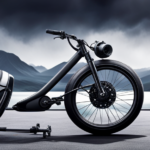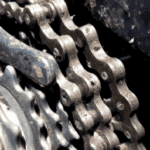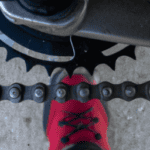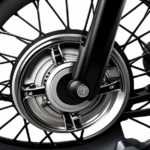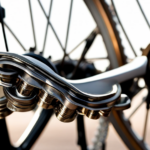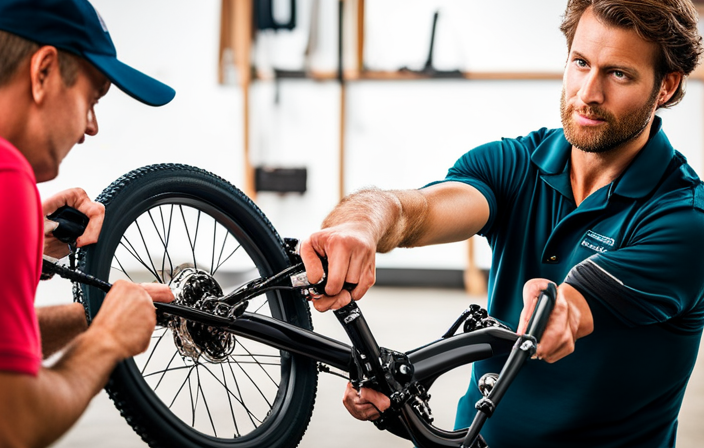Riding an electric bike is like gliding through the wind, but when that smooth experience is interrupted by a mysterious clicking noise, it can be frustrating. In this article, I will delve into the world of electric bike motors and explore the reasons behind this perplexing issue.
By examining loose parts, the brake system, chain and gears, pedals and crankset, battery and power system, and ensuring proper lubrication, we can uncover the source of the clicking noise and restore the tranquility of your ride.
Key Takeaways
- Importance of using the right lubricant for electric bike motors
- Common maintenance mistakes to avoid
- Seeking professional assistance for complex mechanical problems
- Preventive maintenance tips to avoid clicking noises
Understanding the Clicking Noise in Electric Bike Motors
You might be wondering why your electric bike motor makes a clicking noise when you start to slow down. The clicking noise in electric bike motors can be caused by several common factors.
One possible cause is a loose chain. When the chain is not properly tensioned, it can slip and create a clicking sound.
Another possible cause is a worn-out gear or sprocket. Over time, the teeth on the gears can become worn, causing them to skip and make a clicking noise.
Additionally, the clicking noise could be due to a malfunctioning freewheel or clutch mechanism. To troubleshoot the issue, you can start by checking the chain tension and ensuring it is properly tightened. If the chain is fine, inspect the gears for any signs of wear and replace them if necessary.
Finally, if the freewheel or clutch mechanism is faulty, it may need to be repaired or replaced.
Checking for Loose Parts and Connections
First, check for any loose parts or connections. This is an important step in troubleshooting the clicking noise in your electric bike motor. Loose cables or connections can cause vibrations and rattling, resulting in the clicking sound. Inspect all the cables and connections, including the battery connections, motor cables, and controller connections. Make sure they are securely fastened and tightened.
In addition to checking for loose parts and connections, it is also essential to inspect the bearings in your electric bike motor. Worn bearings can cause clicking noises when they become loose or damaged. Carefully examine the motor bearings for any signs of wear or damage. If you notice any issues, it is recommended to replace the bearings to eliminate the clicking noise.
Here is a table to summarize the steps for checking loose parts and connections:
| Steps | Description |
|---|---|
| Step 1: Inspect cables | Check all the cables, including battery connections, motor cables, and more. |
| Step 2: Check connections | Ensure all connections are securely fastened and tightened. |
| Step 3: Examine bearings | Inspect the motor bearings for wear or damage. |
| Step 4: Replace if needed | If bearings are worn or damaged, replace them to eliminate the clicking noise. |
Examining the Brake System
Next, examine the brake system to identify any potential issues that could be causing the clicking sound. When examining the brake system, start by checking the brake pads. Look for any signs of wear or damage on the brake pads, such as uneven surfaces or excessive thickness. If the brake pads are worn out or damaged, they may need to be replaced.
Next, troubleshoot the brake calipers. Inspect the calipers for any loose or broken components. Make sure that the caliper bolts are tightened properly and that there are no signs of damage or corrosion. Additionally, check the brake caliper pistons for smooth operation. They should move freely and evenly when the brake lever is applied.
To further troubleshoot the brake system, check the brake rotor for any signs of damage, such as warping or excessive wear. A damaged rotor can cause irregular contact with the brake pads, leading to a clicking sound.
Finally, ensure that the brake system is properly aligned. Misalignment can cause the brake pads to make contact with the rotor unevenly, resulting in a clicking noise. Adjust the brake caliper position if necessary to achieve proper alignment.
Identifying Issues with the Chain and Gears
When examining the chain and gears, it is important to check for any signs of wear or damage. Identifying common causes of clicking noises in the electric bike motor when slowing down can often be traced back to issues with the chain and gears.
One common cause is a loose chain, which can create a clicking sound as it jumps on the gears. To troubleshoot this, ensure that the chain tension is properly adjusted and that the chain is well lubricated.
Another potential issue is misaligned gears, which can cause the chain to rub against them, resulting in a clicking noise. To fix this, carefully align the gears and ensure they are properly tightened.
Additionally, worn-out gears or a damaged chain can also lead to clicking noises. If this is the case, it is important to replace the affected components to resolve the issue.
By following these troubleshooting tips and tricks, you can identify and address any issues with the chain and gears that may be causing the clicking noise when slowing down.
Inspecting the Pedals and Crankset
To inspect the pedals and crankset, you should check for any signs of wear or damage. Start by examining the frame alignment to ensure it is straight and properly aligned. Any misalignment can cause issues with the pedals and crankset.
Next, check the pedal bearings for any looseness or excessive play. Rotate the pedals and listen for any clicking or grinding noises, as these can indicate a problem with the bearings.
Additionally, inspect the crankset for any cracks or bends, as these can affect the smooth operation of the pedals. Ensure that the crank arms are securely attached to the bottom bracket spindle.
By thoroughly inspecting the pedals and crankset, you can identify any issues that may be causing the clicking noise when slowing down on your electric bike.
Addressing Problems with the Freewheel or Cassette
One way to address problems with the freewheel or cassette is by inspecting them for any signs of wear or damage. When troubleshooting issues with the electric bike motor making a clicking noise when slowing down, it is important to consider these components.
Common causes of clicking noises can be attributed to worn teeth on the freewheel or cassette. To inspect them, start by visually examining the teeth for any signs of wear, such as rounded edges or missing teeth. Additionally, check for any loose or damaged parts, such as loose cogs or a bent cassette.
If any issues are found, it may be necessary to replace the freewheel or cassette to resolve the clicking noise. Regular maintenance and proper lubrication can help prevent these problems from occurring in the future.
Checking the Battery and Power System
Checking the battery and power system is an essential step in troubleshooting any issues with an electric bike. To effectively troubleshoot the problem, consider the following troubleshooting techniques:
-
Inspect the battery connections: Ensure that all connections are secure and free from corrosion. Loose or dirty connections can result in power loss and erratic behavior.
-
Test the battery voltage: Use a multimeter to measure the voltage of the battery. A low voltage reading may indicate a weak or failing battery that needs to be replaced.
-
Check the power controller: Examine the power controller for any signs of damage or malfunction. Faulty power controllers can cause intermittent power loss or incorrect power output.
-
Look for common causes: Common causes of battery and power system issues include a drained battery, faulty wiring, or a malfunctioning charger. Addressing these common causes can often resolve the clicking noise when slowing down.
By following these troubleshooting techniques and addressing common causes, you can effectively diagnose and resolve any issues with the battery and power system of your electric bike.
Lubricating Moving Parts for Smooth Operation
Make sure you lubricate the moving parts regularly for a smooth operation. When it comes to electric bike motors, using the right lubricant is crucial. There are different types of lubricants available, such as chain lubricants and bearing greases, designed specifically for different parts. Chain lubricants are ideal for chains, while bearing greases work well for bearings and other rotating parts. It’s important to choose a lubricant that is compatible with your electric bike motor and follow the manufacturer’s recommendations.
In addition to using the right lubricant, it’s important to avoid common maintenance mistakes that can affect the performance of your electric bike motor. One common mistake is over-lubricating the moving parts. Applying too much lubricant can attract dirt and dust, leading to increased friction and potential damage. Another mistake is neglecting to clean the parts before applying lubricant. Dirt and debris can mix with the lubricant, resulting in poor performance.
Regularly inspecting and cleaning the moving parts, and applying the appropriate amount of lubricant, will help ensure a smooth and efficient operation of your electric bike motor.
Seeking Professional Assistance if Needed
After attempting to lubricate the moving parts of my electric bike motor, I realized that the clicking noise when slowing down was still persisting. It became clear that I needed to seek professional assistance to address this issue effectively.
Seeking professional help is crucial when troubleshooting complex mechanical problems like this one. A qualified electric bike technician will have the knowledge and experience to diagnose the exact cause of the clicking noise. They can use specialized tools and techniques to conduct a thorough inspection of the motor and identify any underlying issues.
In addition to seeking professional help, there are some troubleshooting techniques that can be tried before taking the bike to a technician. These include checking for loose connections, adjusting the brake pads, and inspecting the chain tension.
Preventive Maintenance Tips to Avoid Clicking Noises
To prevent clicking noises, you should regularly maintain your electric bike by performing routine inspections and adjustments. By following preventive maintenance techniques, you can avoid potential issues that may lead to clicking noises when slowing down.
One common cause of clicking noises is a loose chain. Ensure that your chain is properly tensioned and lubricated to prevent any unnecessary noise. Additionally, check your brake pads for wear and tear and replace them if necessary.
Another possible cause is loose or worn-out components, such as the bottom bracket or pedal arms. Regularly inspect these parts and tighten or replace them as needed.
Lastly, make sure that your wheel bearings are properly adjusted and lubricated to minimize any clicking sounds.
By incorporating these preventive maintenance tips, you can enjoy a smooth and quiet ride on your electric bike.
Frequently Asked Questions
Can the clicking noise in electric bike motors cause any damage to the bike or its components?
To reduce clicking noise in electric bike motors, regular maintenance is essential. Lubricating the moving parts, checking for loose components, and ensuring proper alignment can help minimize the noise. Common misconceptions about the impact of clicking noise on electric bike motors include the belief that it can cause damage to the bike or its components, whereas it is often just a normal operational sound.
How can I determine if the clicking noise is originating from the motor or another part of the bike?
To determine the source of the clicking noise, I would engage in troubleshooting steps. These steps include inspecting the motor, checking the chain and gears, and observing any loose or worn components.
Is it common for electric bike motors to make clicking noises when slowing down, or could it be a sign of a larger issue?
It is common for electric bike motors to make clicking noises when slowing down. However, it could also indicate a larger issue with the motor. Proper electric bike motor maintenance can help prevent common issues and ensure smooth operation.
Are there any troubleshooting steps I can take before seeking professional assistance for a clicking noise in the motor?
I can suggest some troubleshooting steps and DIY fixes to address a clicking noise in the motor. First, check for loose or damaged components. Then, clean and lubricate the motor. If the issue persists, it’s best to seek professional assistance.
Can the clicking noise be eliminated by adjusting or replacing certain parts, or is it a normal characteristic of electric bike motors?
Can the clicking noise in electric bike motors be eliminated by adjusting or replacing certain parts? Or is it a normal characteristic? Let’s explore the technical details and possibilities of adjusting or replacing parts to address this issue.
Conclusion
In conclusion, addressing the clicking noise in electric bike motors requires a systematic approach. By checking for loose parts and connections, examining the brake system, identifying issues with the chain and gears, inspecting the pedals and crankset, and checking the battery and power system, one can troubleshoot and resolve the problem.
Additionally, regular lubrication of moving parts is crucial for smooth operation. Remember, an ounce of prevention is worth a pound of cure, so follow the preventive maintenance tips to avoid those pesky clicking noises.
Now, let’s hit the road and enjoy a smooth, noise-free ride!


